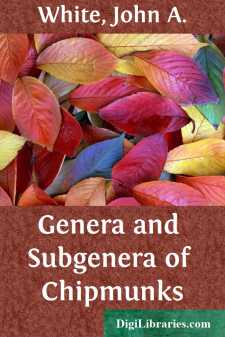Categories
- Antiques & Collectibles 13
- Architecture 36
- Art 48
- Bibles 22
- Biography & Autobiography 813
- Body, Mind & Spirit 142
- Business & Economics 28
- Children's Books 15
- Children's Fiction 12
- Computers 4
- Cooking 94
- Crafts & Hobbies 4
- Drama 346
- Education 46
- Family & Relationships 57
- Fiction 11828
- Games 19
- Gardening 17
- Health & Fitness 34
- History 1377
- House & Home 1
- Humor 147
- Juvenile Fiction 1873
- Juvenile Nonfiction 202
- Language Arts & Disciplines 88
- Law 16
- Literary Collections 686
- Literary Criticism 179
- Mathematics 13
- Medical 41
- Music 40
- Nature 179
- Non-Classifiable 1768
- Performing Arts 7
- Periodicals 1453
- Philosophy 64
- Photography 2
- Poetry 896
- Political Science 203
- Psychology 42
- Reference 154
- Religion 513
- Science 126
- Self-Help 84
- Social Science 81
- Sports & Recreation 34
- Study Aids 3
- Technology & Engineering 59
- Transportation 23
- Travel 463
- True Crime 29
Taxonomy of the Chipmunks, Eutamias quadrivittatus and Eutamias umbrinus
by: John A. White
Description:
Excerpt
The differences in anatomy and color between many species of chipmunks are subtle, and refined techniques are required to discover them. When "measuring" chipmunks taxonomically, it is necessary to use a "chipmunk scale" and not, for example, a "pocket-gopher scale." In explanation, some species of pocket gophers closely allied to each other, and even some subspecies of the same species, differ markedly in color and in size and shape of parts of the skeleton; comparable differences are not so pronounced among many species of chipmunks.
Historical Summary
Merriam (1905) was the first to show clearly that Eutamias quadrivittatus is a distinct species, and pointed out that E. amoenus operarius (= E. minimus operarius) is a small species which resembles, and is found in some areas together with, E. quadrivittatus.
Howell (1929) placed under E. quadrivittatus the following subspecies: E. q. quadrivittatus, E. q. hopiensis, E. q. inyoensis, E. q. frater, E. q. sequoiensis, and E. q. speciosus.
Hardy (1945) placed E. adsitus under E. quadrivittatus as E. q. adsitus, and Kelson (1951) placed E. umbrinus under E. quadrivittatus as E. q. umbrinus.
Johnson (1943) re-established E. speciosus as a separate species, and in California left only E. q. inyoensis in E. quadrivittatus.
Thus, since 1943 the recognized subspecies of E. quadrivittatus have been: E. q. quadrivittatus, E. q. hopiensis, E. q. inyoensis, E. q. nevadensis, E. q. umbrinus, and E. q. adsitus.
Capitalized color terms, which are used in descriptions and comparisons, are of Ridgway, "Color Standards and Color Nomenclature," Washington, D. C., 1912.
In the synonymy of each subspecies there appears only the first usage of a name, second the first usage of the name combination now employed unless a new combination is proposed by me, and third pure synonyms. The last is recognizable as such because the type locality is appended to each.
Unless otherwise specified, all specimens are in the Museum of Natural History, University of Kansas. The various collections of institutions and of private persons are indicated by the following symbols:
AM—American Museum of Natural History.
BS—United States Biological Surveys Collection.
CM—Colorado Museum of Natural History.
DC—Collection of Donald R. Dickey (now the collection of the University of California at Los Angeles).
FC—Collection of James S. Findley.
KU—Museum of Natural History, University of Kansas.
MM—Museum of Zoology, University of Michigan.
NM—United States National Museum.
UU—Museum of Zoology, University of Utah.
WC—Collection of Edward R. Warren, Colorado College.
Of the external measurements, only the total length and the length of the tail are recorded in table 1. Some field collectors measured the ear from the notch and others from the crown; most collectors measured the length of the hind foot to the nearest millimeter rather than in tenths of a millimeter, as would have been desired. Consequently, I decided against using the lengths of the ear and hind foot in the study here reported on.
The measurements of the skull were made as shown in figure 1.
Fig. 1. Dorsal view of skull and a lateral and a medial view of the right lower jaw to show points between which measurements of the skull were taken. × 1¾. Based on Eutamias ruficaudus ruficaudus, from 6 mi. S St. Mary, 6500 ft., Glacier Co., Montana. A to A'—greatest length of skull; B to B'—length of nasals; C to C'—zygomatic breadth; D to D'—least interorbital constriction; E to E'—cranial breadth; F to F'—inner mandibular length; G to G'—condylo-alveolar length of mandible....





